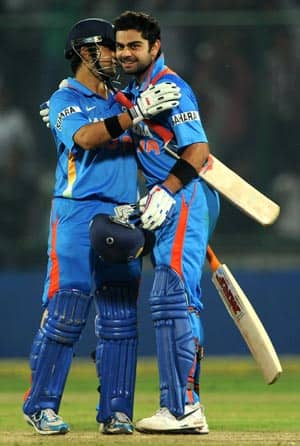Gambhir-Kohli in ODIs are what Dravid-Laxman are in Test matches
Gambhir and Dravid in ODI is like Laxman-Dravid in Test
By Nishad Pai Vaidya
Virat Kohli and Gautam Gambhir’s match-winning partnership at Delhi was an exhibition of power and dominance. India were in trouble as they lost their openers early, but the two Delhi boys dazzled on their home turf and didn’t let England make any further inroads. They were under pressure when they met in the middle and showed the grit to see off the initial phase. In the end, India romped home to a comprehensive win as the local boys capped the good work done by the Indian bowlers earlier in the day.
It’s pertinent to note the number of times India have been on the winning side when the two have spent considerable time in the middle.
Here are their overall partnership stats:
| M | Runs | Avge | 100s | 50s |
| 20 | 1303 | 72.38 | 4 | 3 |
The important fact is that India have won on each occasion when they put over a hundred together. Two of these stands have been unbeaten and have taken India through to victory in their run chase, the latest effort coming at Delhi. Two of those century stands crossed the 200 run mark and rescued India from a muddle.
The first time the two were involved in an epic partnership was at Kolkata in 2009 against Sri Lanka. Sri Lanka batted first and set India a total of 316. In the fourth over, India were reduced to 23 for two with both Sachin Tendulkar and Virender Sehwag back in the hut. Kohli was just finding his feet in the Indian team then and one would have imagined that it would have been tough ask for him. However, he and Gambhir got into the act and were together for 224 runs. In the process, Kohli scored his first ODI hundred and Gambhir anchored the innings to the end.
Their best effort, arguably, was probably their crucial 83-run partnership in the biggest match of their lives – the final of the 2011 ICC Cricket World Cup final – which provided the platform for the historic victory. Kohli and Gambhir came together and faced a similar situation to Kolkata 2009. At 31 for two, India had lost both Tendulkar and Sehwag, chasing 275 to lift the World Cup. Compared to Kolkata 2009, the score was relatively smaller, but considering the pressure of chasing in a final with two quality players out, the target of 275 could have been tougher than a run-chase of 300. The two of them measured their approach, avoided taking risks early on and saw off Lasith Malinga’s lethal spell.
When they got their eye in, they decided to take calculated risks and started upping the ante. They rotated the strike well and struck the occasional boundary to frustrate the Sri Lankan bowlers. Their partnership calmed the nerves of the Indian team and handled the biggest stage with perfection. Kohli was unlucky to lob a catch back to Tillakaratne Dilshan, but Gambhir continued to play the knock of his life. In the end, it was Mahendra Singh Dhoni who was hailed as the hero, but no one can take anything away from the World Cup-winning stand.
Gambhir and Kohli are very similar players when it comes to their approach. They are technically correct and play with the straight bat early in their innings. Once they get settled they try to go for the boundaries but only if the ball is in their zone. The gaps are targeted very well and they pierce the field with ease. Their understanding with regards to running between the wickets is outstanding. One wouldn’t see them tentative in their running which indicates a good knowledge of each other’s game.
Time and again, the two Delhi boys have struck big for India in ODIs. In pressure situations they have restored calm to the proceedings which has helped India clinch victories after initial difficulties. My mind cannot help but remember the numerous occasions when VVS Laxman and Rahul Dravid have saved India in Test matches. Kohli and Gambhir are the new Laxman-Dravid association for India in ODIs.
(Nishad Pai Vaidya, a 21-year-old law student, is a club and college-level cricketer. His teachers always complain, “He knows the stats and facts of cricket more than the subjects we teach him.”)
